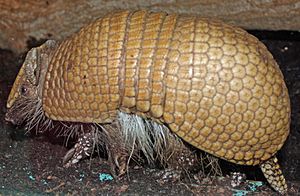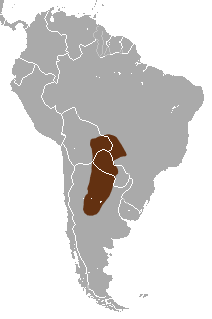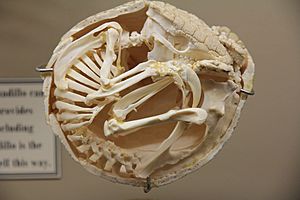Southern three-banded armadillo facts for kids
Quick facts for kids Southern three-banded armadillo |
|
|---|---|
 |
|
| Southern three-banded armadillo at the Louisville Zoo | |
| Conservation status | |
| Scientific classification | |
| Genus: |
Tolypeutes
|
| Species: |
matacus
|
 |
|
| Southern three-banded armadillo range | |

The southern three-banded armadillo is a special animal from South America. It is also known as the La Plata three-banded armadillo. You can find it in parts of Argentina, Brazil, Paraguay, and Bolivia. These armadillos live from sea level up to about 770 meters (2,526 feet) high.
Contents
Meet the Southern Three-Banded Armadillo
The southern three-banded armadillo is one of only two armadillo species that can roll into a perfect ball. This amazing trick helps them stay safe from predators. When they feel scared, they tuck their head and tail together. This protects their soft belly, legs, eyes, nose, and ears.
What Makes Them Special?
Their name comes from the three flexible bands on their back. These bands let them bend enough to curl up tightly. Their body is covered by a strong, armored shell. This shell is made of keratin, which is the same stuff as your fingernails!
These armadillos are usually yellow or brownish. They are among the smaller armadillos. Their body is about 22 to 27 centimeters (8.7 to 10.6 inches) long. They weigh between 1 and 1.6 kilograms (2.2 to 3.5 pounds).
Unlike most armadillos, they do not dig their own burrows. Instead, they use old burrows made by giant anteaters.
What Do They Eat?
The three-banded armadillo has a long, sticky, pink tongue. This tongue helps them catch and eat many kinds of insects. Their favorite foods are ants and termites. If they live in a zoo, they also enjoy eating fruits and vegetables.
Where Do They Live and Why Are They Important?
These armadillos live in a dry area called the Dry Chaco. This area is changing because people are turning it into farmland. This means the armadillos are losing their homes. They are also sometimes hunted for food or sold as pets. Because of these reasons, they are a species that needs our help to survive.
Images for kids
See also
 In Spanish: Corechi para niños
In Spanish: Corechi para niños




